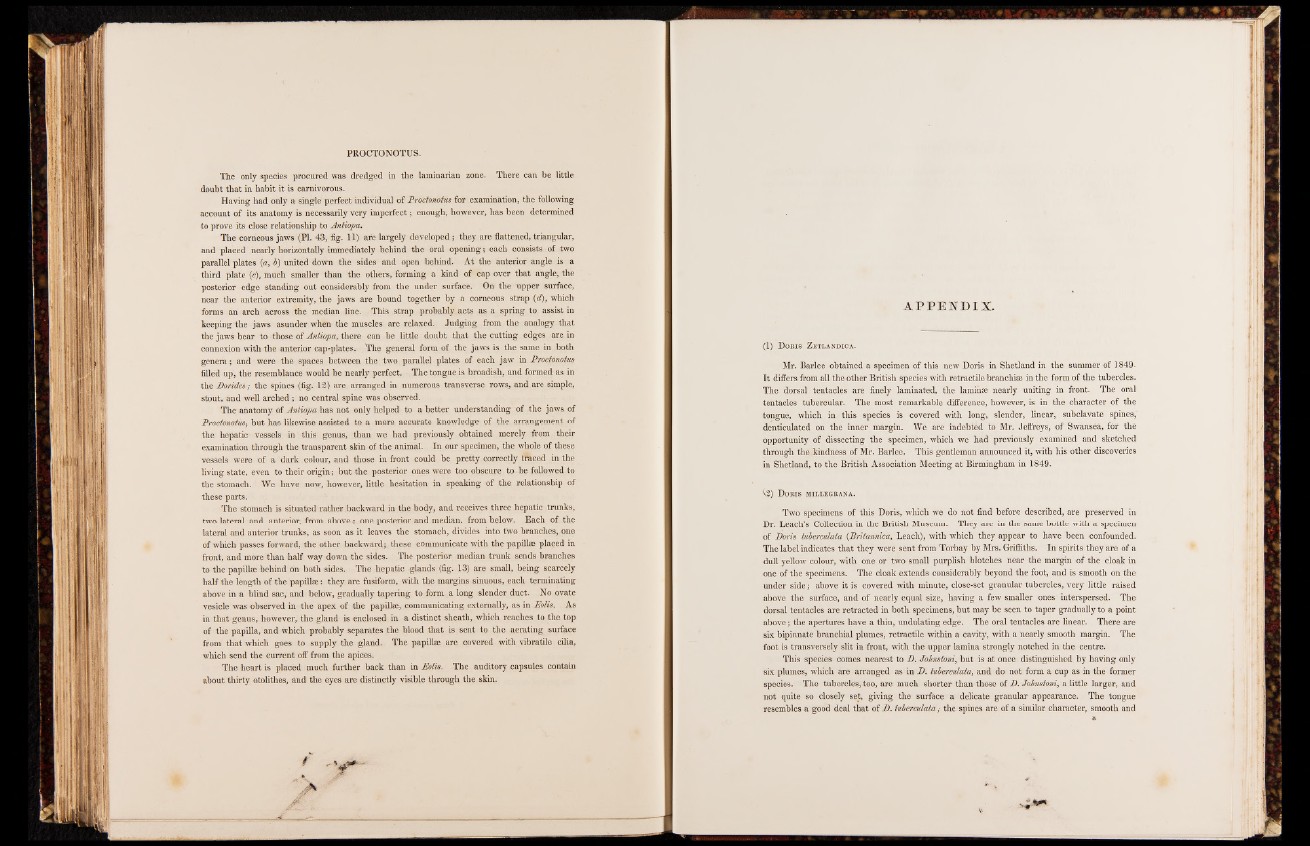
PROCTONOTUS.
The only species procured was dredged in the laminarian zone. There can be little
doubt that in habit it is carnivorous.
Having had only a single perfect individual of Prodonotus for examination, the following
account of its anatomy is necessarily very imperfect; enough, however, has been determined
to prove its close relationship to Antiopa.
The corneous jaws (PL 43, fig. 11) are largely developed; they are flattened, triangular,
and placed nearly horizontally immediately behind the oral opening; each consists of two
parallel plates {a, b) united down the sides and open behind. At the anterior angle is a
third plate (c), much smaller than the others, forming a kind of cap over that angle, the
posterior edge standing out considerably from the under surface. On the upper surface,
near the anterior extremity, the jaws are bound together by a corneous strap (d), which
forms an arch across the median line. This strap probably acts as a spring to assist in
keeping the jaws asunder when the muscles are relaxed. Judging from the analogy that
the jaws bear to those of Antiopa, there can be little doubt that the cutting edges are in
connexion with the anterior cap-plates. The general form of the jaws is the same in both
genera; and were the spaces between the two parallel plates of each jaw in Prodonotus
filled up, the resemblance would be nearly perfect. The tongue is broadish, and formed as in
the Dorides; the spines (fig. 12) are arranged in numerous transverse rows, and are simple,
stout, and well arched ; no central spine was observed.
The anatomy of Antiojja has not only helped to a better understanding of the jaws of
Prodonotus, but has likewise assisted to a more accurate knowledge of the arrangement of
the hepatic-vessels in this genus, than we had previously obtained merely from their
examination through the transparent skin of the animal. In our specimen, the whole of these
vessels were of a dark colour, and those in front could be pretty correctly traced in the
living state, even to their origin; but the posterior ones were too obscure to be followed to
the stomach. We have now, however, little hesitation in speaking of the relationship of
these parts.
The stomach is situated rather.backward in the body, and receives three hepatic trunks,
two lateral and anterior, from above $ one posterior and median, from below. Each of the
lateral and anterior trunks, as soon as it leaves the stomach, divides into two branches, one
of which passes forward, the other backward; these communicate with the papillae placed in
front, and more than half way down the sides. The posterior median trunk sends branches
to the papillae behind on both sides. The hepatic glands (fig. 13) are small, being scarcely
half the length of the papillae: they are fusiform, with the margins sinuous, each terminating
above in a blind sac, and below, gradually tapering to form a long slender duct. No ovate
vesicle was observed in the apex of the papillae, communicating externally, as in Polis. As
in that genus, however, thé gland is enclosed in a distinct sheath, which reaches to the top
of the papilla, and which probably separates the blood that is sent to the aerating surface
from that which goes to supply the gland. The papillae are covered with vibratile cilia,
which send the current off from the apices.
The heart is placèd much further back than in Polis. The auditory capsules contain
about thirty otolithes, and the eyes are distinctly visible through the skin.
APPENDIX.
(1) Doris Zetlandica.
Mr. Barlee obtained a specimen of this new Doris in Shetland in the summer of 1849.
It differs from all the other British species with retractile branchiae in the form of the tubercles.
The dorsal tentacles are finely laminated, the laminae nearly uniting in front. The oral
tentacles tubercular. The most remarkable difference, however, is in the character of the
tongue, which in this species is covered with long, slender, linear, subclavate spines,'
denticulated on the inner margin. We are indebted to Mr. Jeffreys, of Swansea, for the
opportunity of dissecting the specimen, which we had previously examined and sketched
through the kindness of Mr. Barlee. This gentleman announced it, with his other discoveries
in Shetland, to the British Association Meeting at Birmingham in 1849.
(.2) Doris millegrana.
Two specimens of this Doris, which we do not find before described, are preserved in
Dr. Leach’s Collection in the British Museum. They are in the same bottle with a specimen
of Doris tuberculata (.Britannica, Leach), with which they appear to have been confounded.
The label indicates that they were sent from Torbay by Mrs. Griffiths. In spirits they are of a
dull yellow colour, with one or two small purplish blotches near the margin of the cloak in
one of the specimens. The cloak extends considerably beyond the foot, and is smooth on the
under side; above it is covered with minute, close-set granular tubercles, very little raised
above the surface, and of nearly equal size, having a few smaller ones interspersed. The
dorsal tentacles are retracted in both specimens, but may be seen to taper gradually to a point
above; the apertures have a thin, undulating edge. The oral tentacles are linear. There are
six bipinnate branchial plumes, retractile within a cavity, with a nearly smooth margin. The
foot is transversely slit in front, with the upper lamina strongly notched in the centre.
This species comes nearest to D. Johnstoni, but is at once distinguished by having only
six plumes, which are arranged as in D. tuberculata, and do not form a cup as in the former
species. The tubercles, too, are much shorter than those of D. Johnstoni, a little larger, and
not quite so closely set, giving the surface a delicate granular appearance. The tongue
resembles a good deal that of D. tuberculata; the spines are of a similar character, smooth and
*